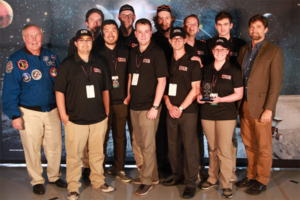 The University of Utah’s Utah Student Robotics (USR) team competed for the fourth time May 14-18 at NASA’s Kennedy Space Center for the NASA RMC (Robotic Mining Challenge), winning the SSERVI (Solar System Exploration Research Virtual Institute) Regolith Mechanics Award as well as 2nd place in the Presentation and Demonstration Award. And the team won with a completely redesigned robot due to changes in the competition rules.
The University of Utah’s Utah Student Robotics (USR) team competed for the fourth time May 14-18 at NASA’s Kennedy Space Center for the NASA RMC (Robotic Mining Challenge), winning the SSERVI (Solar System Exploration Research Virtual Institute) Regolith Mechanics Award as well as 2nd place in the Presentation and Demonstration Award. And the team won with a completely redesigned robot due to changes in the competition rules.
NASA RMC is an annual competition held at Kennedy Space Center that tasks over 50 collegiate teams with building a mining robot and mining gravel from beneath the surface of a simulated Martian terrain. The competition challenge is to mine the precious icy regolith (gravel). This water ice will provide oxygen, water and fuel for future off-world colonists. Robots must navigate the difficult and foreign terrain utilizing autonomy, then must reach a dig depth of 12 inches to collect the buried regolith and return the material to a collection bin within a 10-minute round.
The USR team was composed of about two dozen students from the University of Utah’s mechanical engineering, electrical and computer engineering, computer science and engineering, and geology departments. Eleven students from the U made the journey to Cape Canaveral, Florida.
“We had a great time working together to solve issues and malfunctions as they arose and getting to know all the fellow teams and volunteers,” Mechanical engineering graduate Dorothy Van Komen said. “It was incredible being at NASA and getting to meet other wonderful university students and to hear nice feedback from NASA engineers. Everyone had a great attitude even in the face of a failing robot. We never stopped trying to help fellow teammates and the other teams.”
“Although the robot didn’t manage to have a qualifying run,” adds Van Komen, “few schools did between the weather delays and the rule changes. We are proud of what we were able to accomplish this past year and proud of the design and friendly legacy we are passing on to next year’s team. At the competition our team and our ideas performed well with the judges. Judges were especially interested in our utilization of advanced 3D printing, which included rubber airless tires, nylon digging buckets, and titanium sprocket hubs.”